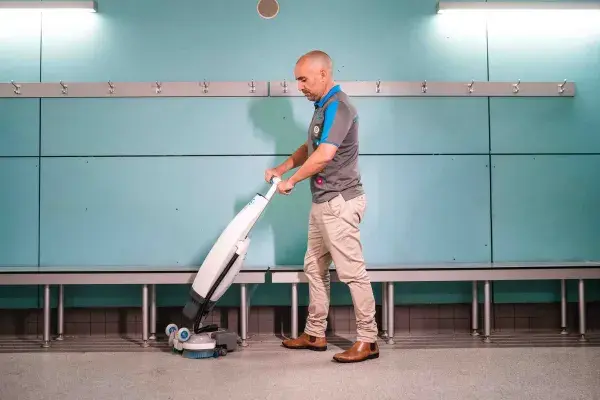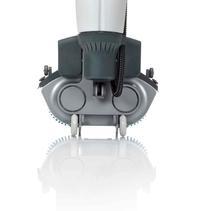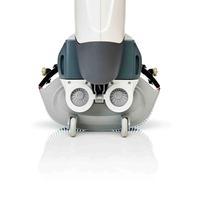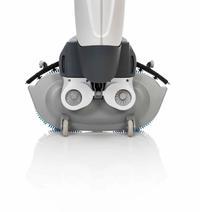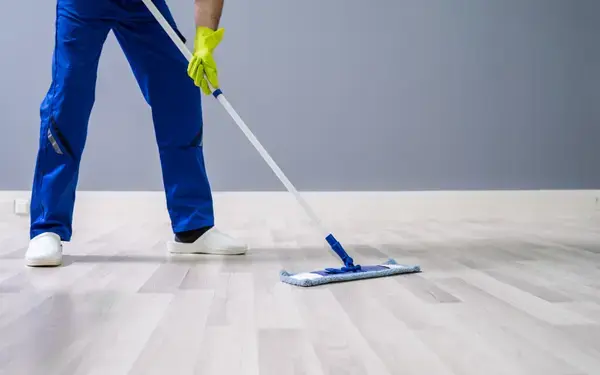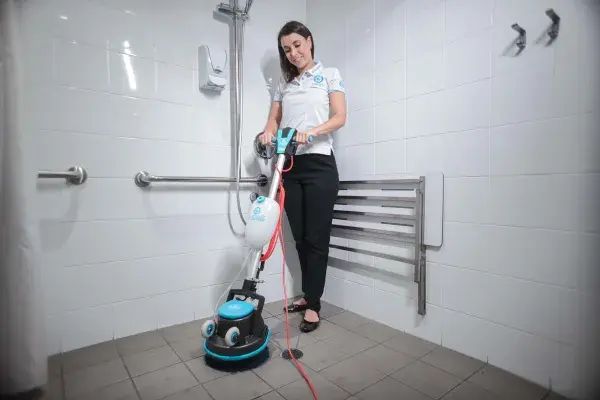You are reading: 6 Mistakes to Avoid When Cleaning Floors
21 June 2023
5min read time
Brooke Payne
6 Mistakes to Avoid When Cleaning Floors
Share:

Key Insights
- Using the correct mopping technique, such as a figure-eight motion, and changing the mop water regularly ensures better dirt removal and avoids streaks.
- Choosing the right cleaning products for specific floor types prevents damage, streaks, and residue.
- Wearing flat-soled, non-slip shoes or indoor cleaning slippers helps avoid leaving marks on hard floors, maintaining their cleanliness.
Cleaning a floor may seem like a straightforward task, but even experienced professionals can make mistakes without realising it. In this article, we'll explore some common cleaning industry blunders that can affect the level of cleanliness you can achieve. By understanding and avoiding these mistakes, you'll be well-equipped to keep your floors impeccably clean. So, let's uncover these common mistakes and take a look at the secrets to maintaining spotless floors!
1. Using Incorrect Technique when Mopping
When it comes to cleaning floors, we often envision the repetitive back-and-forth motion of mopping, likely influenced by movies or TV shows. However, using improper mopping techniques can lead to streaks, inefficient dirt removal, or even spreading dirt around instead of effectively cleaning it.
To achieve optimal results, it's essential to follow the right technique. Begin by sweeping or vacuuming the floor to eliminate loose debris. This initial step prepares the surface for mopping. When it's time to mop, employ a figure-eight motion, which ensures even coverage and better dirt removal. Avoid the temptation to mop back and forth, as this can leave unsightly streaks.
Additionally, it's crucial to change the mop water regularly during the cleaning process. Using dirty water will only result in spreading dirt and grime across the floor instead of removing it. By maintaining clean water throughout the mopping process, you'll achieve a more hygienic and polished finish.
For larger areas that require efficiency and a deeper clean, consider using innovative cleaning solutions such as a flexible upright floor scrubber like the i-mop . By incorporating machinery into your cleaning routine, you can bid farewell to concerns about proper technique and let the machine take care of the hard work for you.

2. Using the Wrong Product
Ensuring you choose the appropriate cleaning product for your floors is essential to prevent any potential damage, streaks or marks.
While it may be tempting to grab the nearest floor cleaner without a second thought, take a moment to check its compatibility with your specific floor. This is because many cleaners containharsh chemicals that can harm the finish, cause discoloration, or leave bothersome residue on certain types of flooring.
To ensureoptimalresults, it is recommended to choose high-quality and environmentally friendly products specifically designed for your type of flooring.
Additionally, when dealing with larger spaces, it is equally important to consider the machinery you use. Using inappropriate machinery can unintentionally result in damage or wear on the floor surface. Therefore, investing in equipment that is suitable for the task at hand and compatible with your specific flooring material is crucial.
For a quick overview of the pH scale and to help you determine what product is best for your space click here.
3. Wearing the Wrong Shoes for the Job
Imagine this: You enter a beautiful, well-maintained office space where the floors glisten under the glow of the lights. The cleaning crew diligently works their magic, ensuring every nook and cranny is pristine. However, as they finish their job, they unknowingly leave behind a trail of frustrating footprints on the freshly cleaned floor. What went wrong? It all comes down to the shoes they wore.
Surprisingly, the choice of footwear can significantly impact the outcome of your cleaning efforts. Shoes with heavy treads or traces of dirt from outside may inadvertently leave unsightly marks or imprints on hard floors. To avoid this, it's essential to opt for flat-soled, non-slip shoes or indoor cleaning slippers specifically designed for the task at hand.
By choosing the right shoes, you can ensure that your footprints remain invisible, allowing the floor's beauty to take center stage. It's a small adjustment that makes a world of difference in achieving that pristine, magazine-worthy shine.
4. Using Dirty Tools
Using dirty tools can hinder your cleaning efforts instead of achieving the desired results. Rather than effectively removing dirt and grime, you might unknowingly spread them around. To ensure your cleaning routine is truly effective, it's crucial to prioritize regular cleaning and sanitization of your essential tools such as floor scrubbers, mops, brooms, brushes, and cloths.
By taking the time to clean and sanitize your tools, you can maintain a truly spotless floor. So, before you start your cleaning task, remember to inspect your tools and ensure they are as clean as possible.
If you are part of the custodial staff responsible for cleaning schools, universities, or childcare centers, we have a comprehensive cleaning checklist designed specifically for your industry. Click here to access it and simplify your cleaning duties.

5. Soaking Tough Stains and Marks
With tough marks and stains on flooring, your first instinct might be to unleash a torrent of cleaning solution, believing that soaking the mark is the ultimate solution. However, the reality is quite different.
Dealing with tough stains requires a more delicate approach. Pouring excessive amounts of cleaning solution and leaving it to soak for extended periods can damage your floors and leave behind unwanted residue. It's essential to follow the instructions provided on the cleaning product and avoid the temptation to overdo it.
Once you've applied the appropriate cleaning solution, don't forget the crucial next step—thorough rinsing. This step ensures that any remnants of the cleaning solution are effectively removed from the floor, leaving it clean and residue-free.
Now, let's talk about those truly challenging cleaning scenarios, like baked-on chewing gum or stubborn graffiti. While soaking can be beneficial in these cases, there's an even better solution. Introducing the i-remove, a powerful machine designed specifically for tough removal tasks. With its hot steam feature, it effortlessly tackles gum, graffiti, and other stubborn substances, making the removal process a breeze. No need for soaking!
6. Not Regularly Maintaining Surfaces
Prevention is often overlooked but holds great significance in maintaining clean and well-maintained floors within the workplace.
By implementing preventive measures tailored to the specific needs of work environments, such as regular floor maintenance routines, proper signage, and prompt spill cleanup protocols, you can significantly reduce the accumulation of dirt, stains, and hazards on the floors. It’s also a great idea to place durable and absorbent matting systems at entrances to trap dirt, moisture, and debris from footwear, reducing the amount brought onto the floors.
Emphasizing prevention not only enhances the overall cleanliness of the workplace but also promotes a safer and more professional environment.
Read: Top 10 questions answered about the i-fibre microfiber cleaning system from i-team.
Conclusion
In conclusion, mastering the art of floor cleaning requires attention to detail and avoiding common mistakes. From choosing the right cleaning products and techniques to wearing appropriate footwear and using clean tools, every step counts. Remember to prioritize prevention and implement simple measures to keep your floors cleaner for longer. With these tips and tricks in mind, you're ready to tackle any floor cleaning challenge and enjoy the satisfaction of pristine, sparkling floors. Happy cleaning!
For more information on our range of cleaning products click here .
Common Questions Answered
1. What are common mistakes made when cleaning floors?
Answer: Common mistakes include using the wrong cleaning solution for the floor type, failing to change mop water frequently, and neglecting to thoroughly sweep or vacuum before mopping.
2. How can improper floor cleaning techniques affect floor longevity?
Answer: Improper cleaning can lead to scratches, dullness, and buildup of grime, which can damage the floor surface and require costly repairs or replacement sooner than expected.
3. What precautions should be taken to avoid slip hazards during floor cleaning?
Answer: To avoid slip hazards, use caution signs, ensure floors are well-dried after cleaning, and choose non-slip cleaning methods or products designed to minimize slipperiness.
References
CleanLink – Common Mistakes When Cleaning Floors
URL: https://www.cleanlink.com/news/article/Common-Mistakes-When-Cleaning-Floors--22776
Facility Cleaning Decisions – Essential Floor Cleaning Tips
URL: https://www.cleanlink.com/facilitymanagement/article/Essential-Floor-Cleaning-Tips--19854
Products Featured Inside this Article
Media and Insights
Join the movement that's changing what clean means.
Be part of a cleaner world. Get a live demo at a time that suits you.
Book a Demo